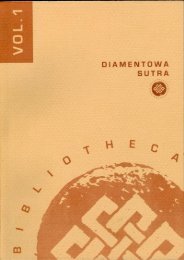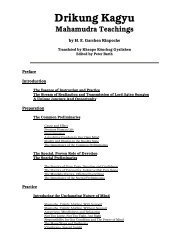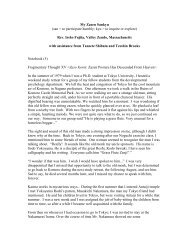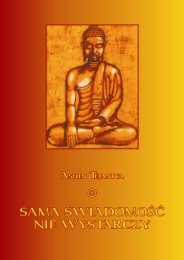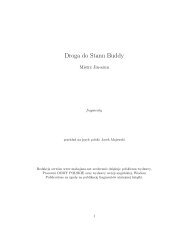3 - Computing in the Humanities and Social Sciences
3 - Computing in the Humanities and Social Sciences
3 - Computing in the Humanities and Social Sciences
Create successful ePaper yourself
Turn your PDF publications into a flip-book with our unique Google optimized e-Paper software.
as Siddhaµ (see also Shirakawa 1976, 1978). Accord<strong>in</strong>gly, with<strong>in</strong> <strong>the</strong> Ch<strong>in</strong>ese cultural<br />
sphere <strong>the</strong> Siddhaµ script was treated not as an alphabet, but as ano<strong>the</strong>r set of<br />
ideograms; fur<strong>the</strong>rmore, those “ideograms” had a peculiarly mystic nature. Staal also<br />
writes:<br />
The Ch<strong>in</strong>ese were not only ready to receive such sacred noises [sic; he<br />
refers here to Buddhist mantras of Indian orig<strong>in</strong>] because <strong>the</strong>y sounded<br />
mysterious, resembled <strong>the</strong> magical formulas of popular Taoism, <strong>and</strong><br />
were suitable for recitation <strong>and</strong> meditation; but <strong>the</strong>y also conformed<br />
precisely to <strong>the</strong>ir own idea of language (Staal 1979b: 7).<br />
As van Gulik expla<strong>in</strong>s: “when confronted with <strong>the</strong> Indian script, <strong>the</strong> Ch<strong>in</strong>ese<br />
decided that each Indian syllables was an ideograph <strong>in</strong> itself, with its own <strong>in</strong>dependent<br />
mean<strong>in</strong>g,” <strong>and</strong> found a confirmation <strong>in</strong> <strong>the</strong> fact that “<strong>in</strong> Indian mysticism every letter<br />
has <strong>in</strong>deed its own mean<strong>in</strong>g” (van Gulik 1980: 39). As a consequence, religious practices<br />
developed based not only on chant<strong>in</strong>g of mantras but also on <strong>the</strong> writ<strong>in</strong>g <strong>and</strong><br />
visualization of Siddhaµ characters.<br />
The Ch<strong>in</strong>ese graphic system, <strong>in</strong> particular its oldest characters, was considered not<br />
as a mere transcription of verbal language (as <strong>in</strong> fact it is), but as a full-fledged system of<br />
representation of reality, constituted by expressive forms harmoniz<strong>in</strong>g sounds <strong>and</strong><br />
colors. On this subject, K¥kai wrote:<br />
When [<strong>the</strong> ancient rulers] had observed <strong>the</strong> chang<strong>in</strong>g of <strong>the</strong> seasons <strong>in</strong><br />
<strong>the</strong> sun, moon, <strong>and</strong> stars, <strong>and</strong> <strong>the</strong> process of transformation at work on<br />
<strong>the</strong> n<strong>in</strong>e cont<strong>in</strong>ents, <strong>the</strong>n with <strong>the</strong> sounds of metal <strong>and</strong> jade, of pipes <strong>and</strong><br />
reeds, <strong>the</strong>y forged <strong>the</strong>ir patterns (wen, Jap. mon) <strong>in</strong> order to nurture <strong>the</strong><br />
common man (K¥kai, Bunkyø hifuron, <strong>in</strong> Købø Daishi Zensh¥ vol. 3: 1.<br />
English translation <strong>in</strong> Bodman 1978: 162).<br />
Kakuban exp<strong>and</strong>ed this ancient Ch<strong>in</strong>ese idea <strong>in</strong> his m<strong>and</strong>ala of <strong>the</strong> five-element<br />
stupa (gor<strong>in</strong> m<strong>and</strong>ara), <strong>in</strong> which <strong>the</strong> five syllables of <strong>the</strong> mantra a bi ra un ken are part of a<br />
rhyzomatic network of cosmic codes based on Ch<strong>in</strong>ese traditional cosmology <strong>and</strong> <strong>the</strong><br />
world view of esoteric Buddhism (on this subject, see lecture 4). In this way, Shittan<br />
were def<strong>in</strong>itively consacrated as “multivalued icons” (Luis Gomez), microcosms,<br />
30



![Shushogi, Dogen Zenji [PDF] - Mahajana.net](https://img.yumpu.com/50921105/1/190x219/shushogi-dogen-zenji-pdf-mahajananet.jpg?quality=85)


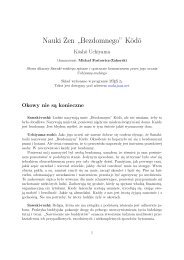

![wywiadu z Murakami Kosho Roshim [PDF] - Buddyzm w Polsce i na ...](https://img.yumpu.com/45809746/1/184x260/wywiadu-z-murakami-kosho-roshim-pdf-buddyzm-w-polsce-i-na-.jpg?quality=85)
